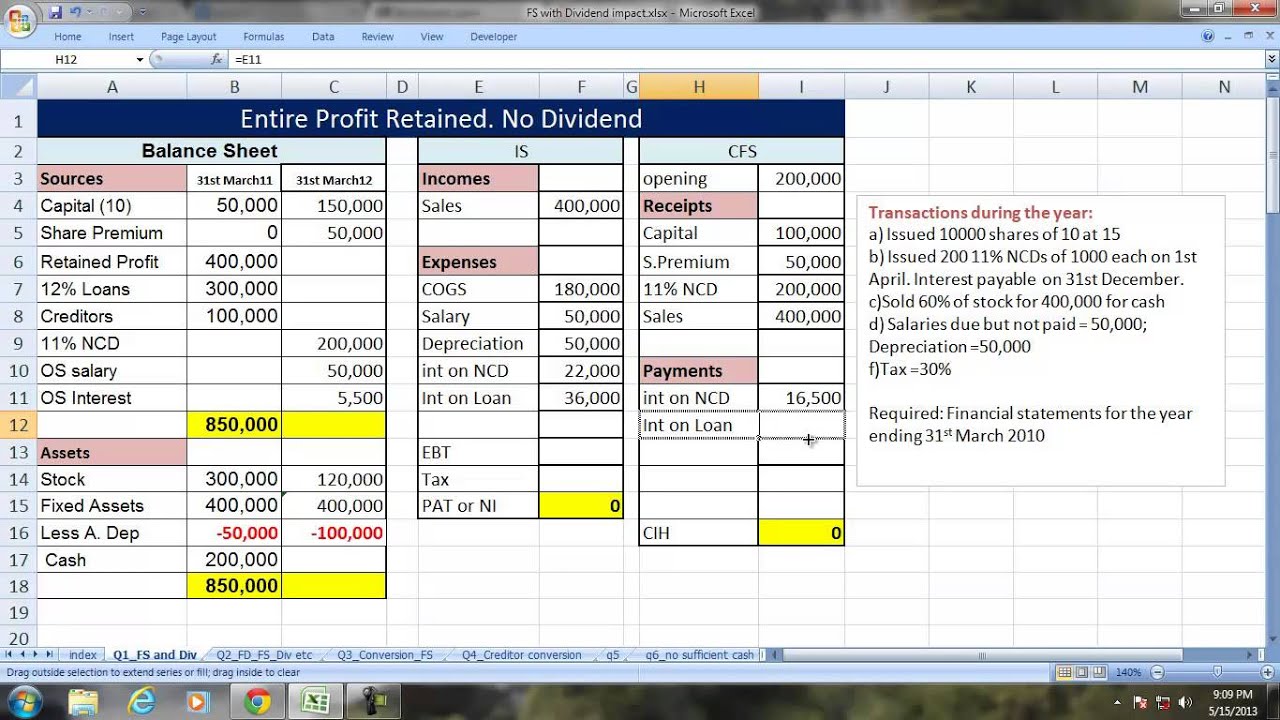Home>Finance>Where In The Financial Statements Do Mergers And Acquisitions Go?


Finance
Where In The Financial Statements Do Mergers And Acquisitions Go?
Published: February 24, 2024
Find out where mergers and acquisitions are reflected in financial statements. Understand the impact on finance and accounting. Learn more about the financial implications of M&A.
(Many of the links in this article redirect to a specific reviewed product. Your purchase of these products through affiliate links helps to generate commission for LiveWell, at no extra cost. Learn more)
Table of Contents
Introduction
In the dynamic and ever-evolving landscape of finance, mergers and acquisitions (M&A) play a pivotal role in shaping the structure and performance of companies. These strategic transactions can significantly impact the financial statements of the involved entities, thereby influencing how investors, stakeholders, and analysts perceive their financial health and prospects.
Understanding the implications of M&A activities on financial statements is crucial for investors, financial professionals, and anyone interested in comprehending the true financial position of a company. By delving into the intricacies of where and how M&A transactions are reflected in financial statements, one can gain valuable insights into the resulting financial metrics and the overall impact on the company's performance.
This article aims to elucidate the placement of mergers and acquisitions within financial statements, offering a comprehensive overview of the topic. By exploring the interplay between M&A transactions and financial reporting, readers will gain a deeper understanding of the significance of these activities in the realm of corporate finance. Let's embark on a journey to unravel the complexities of M&A within the context of financial statements, shedding light on their implications and the ensuing financial implications.
Understanding Mergers and Acquisitions
Mergers and acquisitions (M&A) represent strategic initiatives undertaken by companies to consolidate their operations, expand their market presence, or achieve synergistic benefits. In a merger, two companies combine to form a new entity, thereby pooling their resources, expertise, and market share. On the other hand, an acquisition involves one company purchasing another, leading to the absorption of the target company’s assets, liabilities, and operations into the acquiring entity.
These transactions are often driven by various motives, including the pursuit of economies of scale, access to new technologies or markets, diversification of product offerings, or the desire to eliminate competitors. M&A activities can take different forms, such as horizontal mergers between competitors in the same industry, vertical mergers involving companies within the same supply chain, or conglomerate mergers between unrelated businesses.
Understanding the intricacies of M&A is essential for comprehending their impact on financial statements. The valuation of assets and liabilities, recognition of goodwill, and the treatment of transaction costs are critical aspects that come into play during M&A transactions. Moreover, the accounting treatment of M&A activities can significantly influence the financial metrics and ratios presented in the financial statements, thereby shaping the overall financial narrative of the involved entities.
By delving into the rationale behind M&A transactions and the diverse strategies employed, individuals can gain a comprehensive understanding of the driving forces behind these corporate endeavors. This knowledge forms the foundation for comprehending the subsequent impact of M&A on the financial statements, providing a holistic view of the implications of these transactions within the realm of corporate finance.
Financial Statements Overview
Financial statements serve as the cornerstone of corporate reporting, offering a comprehensive snapshot of a company’s financial performance, position, and cash flows. The primary financial statements include the balance sheet, income statement, statement of cash flows, and statement of changes in equity. Each of these statements plays a distinct yet interconnected role in presenting the financial health and operational efficiency of an organization.
The balance sheet provides a summary of a company’s assets, liabilities, and shareholders’ equity at a specific point in time. It offers insights into the company’s liquidity, solvency, and overall financial strength. On the other hand, the income statement details the revenues, expenses, and profitability over a specified period, elucidating the company’s ability to generate profits from its operational activities.
The statement of cash flows outlines the inflows and outflows of cash and cash equivalents, categorizing them into operating, investing, and financing activities. This statement is instrumental in assessing the company’s ability to generate cash and its utilization for various purposes. Lastly, the statement of changes in equity delineates the changes in the equity of the company, reflecting the impacts of transactions with shareholders and other entities.
These financial statements are prepared in accordance with generally accepted accounting principles (GAAP) or international financial reporting standards (IFRS) to ensure consistency, comparability, and transparency in financial reporting. They are instrumental in facilitating informed decision-making by investors, creditors, and other stakeholders, providing a comprehensive view of the company’s financial performance and position.
Understanding the structure and purpose of financial statements is essential for comprehending the subsequent impact of mergers and acquisitions on these critical reports. The integration of M&A activities into financial statements necessitates a meticulous approach to reflect the resulting changes in the company’s financial position, performance, and cash flows, thereby providing a comprehensive and accurate representation of the post-transaction financial landscape.
Where to Find Mergers and Acquisitions in Financial Statements
When analyzing the impact of mergers and acquisitions (M&A) on financial statements, it is essential to discern the specific sections and line items where these transactions are reflected. The incorporation of M&A activities into financial statements entails meticulous accounting treatment to ensure accurate representation and transparency. Here are the key areas within financial statements where M&A transactions are typically found:
- Balance Sheet: M&A transactions manifest in the balance sheet through the recognition of acquired assets, assumed liabilities, and any resulting changes in equity. The acquired assets are recorded at their fair values, encompassing tangible and intangible assets, while assumed liabilities, such as debts and contractual obligations, are also duly recognized. Moreover, the allocation of the purchase price to identifiable assets and liabilities, including the recognition of goodwill, plays a pivotal role in depicting the financial impact of the transaction on the balance sheet.
- Income Statement: The income statement reflects the impact of M&A activities on the company’s financial performance. This includes the recognition of any one-time expenses related to the transaction, such as acquisition costs or restructuring charges. Additionally, the income statement may encompass the amortization of intangible assets arising from the acquisition, further delineating the ongoing impact of the transaction on the company’s profitability.
- Statement of Cash Flows: M&A transactions can significantly influence the cash flows of the company, particularly in terms of investing and financing activities. Cash outflows related to the acquisition, such as the payment of purchase consideration, are reflected in the investing activities section, while any associated financing activities, such as the incurrence of debt to fund the acquisition, are duly disclosed. Furthermore, the subsequent cash flows from the acquired operations are integrated into the company’s overall cash flow dynamics.
By identifying these distinct areas within the financial statements, stakeholders can gain a comprehensive understanding of the impact of M&A activities on the company’s financial position, performance, and cash flows. The transparent and accurate portrayal of M&A transactions within financial statements is imperative for facilitating informed decision-making and assessing the resulting implications on the company’s financial landscape.
Impact of Mergers and Acquisitions on Financial Statements
Mergers and acquisitions (M&A) exert a profound influence on the financial statements of the involved entities, engendering notable changes in key financial metrics and disclosures. The impact of M&A transactions on financial statements encompasses various facets, each contributing to a comprehensive portrayal of the post-transaction financial landscape. Here are the significant implications of M&A on financial statements:
- Balance Sheet: M&A transactions can lead to substantial adjustments in the balance sheet, reflecting the recognition of acquired assets and assumed liabilities. The valuation of acquired assets at fair values, including intangible assets such as trademarks and customer relationships, can augment the total assets of the company. Simultaneously, the assumption of liabilities, such as contingent obligations and contractual commitments, can impact the company’s overall leverage and solvency ratios.
- Income Statement: The income statement reflects the immediate and ongoing impact of M&A activities on the company’s financial performance. One-time expenses associated with the transaction, such as transaction costs and restructuring charges, can influence the reported profitability for the period in which the transaction occurs. Furthermore, the amortization of intangible assets and the recognition of contingent liabilities can affect the company’s net income and earnings per share.
- Statement of Cash Flows: M&A activities can significantly alter the cash flow dynamics of the company. The initial cash outflows related to the acquisition, including the payment of purchase consideration and transaction costs, are reflected in the investing activities section. Subsequently, the cash flows from the acquired operations, along with any associated financing activities, contribute to the overall cash flow position of the company, impacting its liquidity and capital structure.
Additionally, the disclosure requirements pertaining to M&A transactions in the footnotes to the financial statements play a crucial role in providing context and clarity regarding the underlying rationale, terms, and financial impact of the transaction. These disclosures offer valuable insights into the contingent liabilities, purchase price allocation, and future cash flow expectations, enabling stakeholders to assess the long-term implications of the M&A activities on the company’s financial health.
By comprehensively understanding the impact of M&A on financial statements, investors, analysts, and other stakeholders can make informed assessments of the company’s post-transaction financial position, performance, and cash flows. The transparent and accurate representation of the implications of M&A activities within financial statements is instrumental in fostering trust, facilitating decision-making, and evaluating the overall financial implications of these strategic transactions.
Conclusion
As we navigate the intricate terrain of mergers and acquisitions (M&A) within the realm of financial statements, it becomes evident that these strategic transactions wield a profound impact on the financial reporting of the involved entities. The integration of M&A activities into financial statements necessitates meticulous accounting treatment and comprehensive disclosures to accurately portray the resulting changes in the company’s financial position, performance, and cash flows.
By comprehensively understanding the placement and implications of M&A within financial statements, stakeholders can gain valuable insights into the post-transaction financial landscape. The balance sheet reflects the recognition of acquired assets, assumed liabilities, and the subsequent changes in equity, providing a snapshot of the company’s financial position post-transaction. The income statement delineates the immediate and ongoing impact of M&A activities on the company’s financial performance, encompassing one-time expenses, amortization of intangible assets, and other transaction-related effects. Furthermore, the statement of cash flows captures the alterations in the company’s cash flow dynamics, elucidating the investing and financing activities associated with the M&A transactions.
Moreover, the comprehensive disclosures in the footnotes to the financial statements offer contextual clarity regarding the terms, financial impact, and future expectations related to M&A transactions. These disclosures are instrumental in providing stakeholders with a holistic understanding of the long-term implications of the M&A activities on the company’s financial health and prospects.
Ultimately, the transparent and accurate representation of M&A within financial statements is pivotal for fostering trust, facilitating informed decision-making, and evaluating the overall financial implications of these strategic transactions. By delving into the interplay between M&A and financial reporting, individuals can navigate the complexities of corporate finance with enhanced acumen, enabling them to make informed assessments of the financial health and prospects of the involved entities.
As M&A continue to shape the corporate landscape, the integration of these transactions into financial statements serves as a critical aspect of financial reporting, offering a comprehensive portrayal of the post-transaction financial narrative. By unraveling the intricacies of M&A within financial statements, we pave the way for a deeper understanding of the financial implications and the enduring impact of these transformative transactions.














